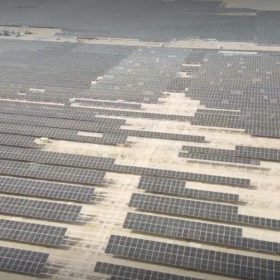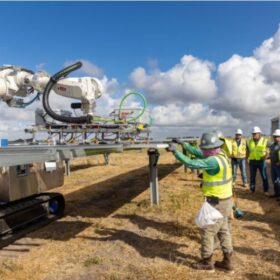It is anticipated that tandem solar cells will initially feature silicon-based bottom cells, a configuration that will leverage the economies of scale and experience of the existing industry. Beyond that, researchers have proposed more ambitious designs employing a triple-junction configuration that could push practical cell efficiencies toward 40%.
Candidate photoabsorber materials must meet challenging criteria. They must be stable under real-world conditions, be affordable to manufacture at scale, and have exceptional efficiency. Emerging materials such as perovskites, kesterites, and organics have demonstrated great potential but have yet to meet all of those requirements. Fortunately, current trends indicate that an emerging material could still become a suitable top-cell material to couple with silicon in a tandem cell. Hurdles remain, however.
Silicon solar cell manufacturers currently offer performance guarantees of modules retaining more than 80% of their initial efficiency for 30 years. That provides the certainty to make a long-term investment. No high efficiency (20%-plus) emerging material has demonstrated comparable stability. Results from the accelerated testing of perovskites have shown encouragingly consistent improvements, however. A better understanding of the failure mechanisms of these devices is necessary, to mitigate them and extend device lifetime.
Benchmarking stability
The PV community has well-established testing protocols for silicon PV modules. This allows for simple comparison of module performance from different research institutes and manufacturers. Protocols for testing devices that incorporate novel photoabsorbers have not yet been fully standardised, with measurement conditions sometimes varying broadly between laboratories. Fortunately, this issue has been identified by the PV research community and international efforts are beginning to converge on agreed testing protocols which will allow for more effective comparisons.
Silicon’s relatively low band gap – the minimum amount of energy needed for an electron to break free – means it will only be suitable as the bottom cell in a tandem device. Fortunately, other materials offer scope to tune their band gap. To date, the majority of investigations have optimised material properties for their application in single-junction devices, meaning researchers have to make significant changes to photoabsorber composition to achieve the desired optoelectronic properties for integrating into a tandem cell.
ACAP and automation
The Australian Centre for Advanced Photovoltaics (ACAP) has a program to address these challenges. Funded by the Australian Renewable Energy Agency, the program is dedicated to investigating emerging materials. This contributes to parallel programs investigating silicon and tandem solar cells and device-to-module translation, and feeds into the ultimate objective of developing ultra-low-cost solar. The goal is to achieve 30% module efficiency at AUD 0.30 ($0.19, translated on 19/03/25)/W system costs by 2030, also known as the 30-30-30 target.
Researchers have developed unique capabilities that will greatly accelerate materials discovery and device optimization. Most notably, a step change has seen processes that typically require huge human labor inputs become nearly fully automated.
CSIRO Manufacturing’s printable PV team has developed a microfactory. It comprises a high-throughput system that replicates the fabrication methods used on the team’s pilot-scale print facility. Fine control of active layer composition and deposition conditions allows for the fabrication of up to 14,000 unique solar cells in a day. Data from this process inform machine-learning algorithms that predict optimised fabrication parameters for better performance.
Researchers at Monash University’s Renewable Energy Laboratory have developed a system that fully automates precursor formulation, solution deposition, and characterisation of novel optoelectronic materials. Developed in conjunction with the Melbourne Centre of Nanofabrication, the system can operate 24/7. It also eliminates the error associated with human handling for highly reproducible and precise results in novel materials discovery.
Large language models (LLMs) also have a role to play. Researchers from the University of New South Wales’ School of Photovoltaics and Renewable Energy Engineering are applying LLMs to scientific literature in a bid to keep better track of developments. An exponential increase in the rate of publication means it is impossible for researchers to keep fully informed of developments in the PV field, let alone of relevant work done outside of the PV domain. This approach summarises research and incorporates it in tailored, scientific LLMs. New discoveries can then be rapidly integrated into future experiments with the goal of self-driving labs allowing for 24/7 operation.
These new tools and techniques will ensure ACAP members remain at the forefront of the emerging materials field and contribute to the global development of next-generation solar cells. Targeting high performance, low cost, and cells and modules that last decades in the field, the aim is to deliver ultra-low-cost solar that will power a renewable energy future for Australia and the world.
Author: Anthony Chesman, group leader of the Renewable Energy Systems (RES) Group at CSIRO and leader of the Emerging Materials Program at ACAP. He works with the RES Group’s printable PV team to advance the manufacture of flexible perovskite and organic solar cells using high-throughput, solution-based printing methods.
The views and opinions expressed in this article are the author’s own, and do not necessarily reflect those held by pv magazine.
This content is protected by copyright and may not be reused. If you want to cooperate with us and would like to reuse some of our content, please contact: editors@pv-magazine.com.








By submitting this form you agree to pv magazine using your data for the purposes of publishing your comment.
Your personal data will only be disclosed or otherwise transmitted to third parties for the purposes of spam filtering or if this is necessary for technical maintenance of the website. Any other transfer to third parties will not take place unless this is justified on the basis of applicable data protection regulations or if pv magazine is legally obliged to do so.
You may revoke this consent at any time with effect for the future, in which case your personal data will be deleted immediately. Otherwise, your data will be deleted if pv magazine has processed your request or the purpose of data storage is fulfilled.
Further information on data privacy can be found in our Data Protection Policy.